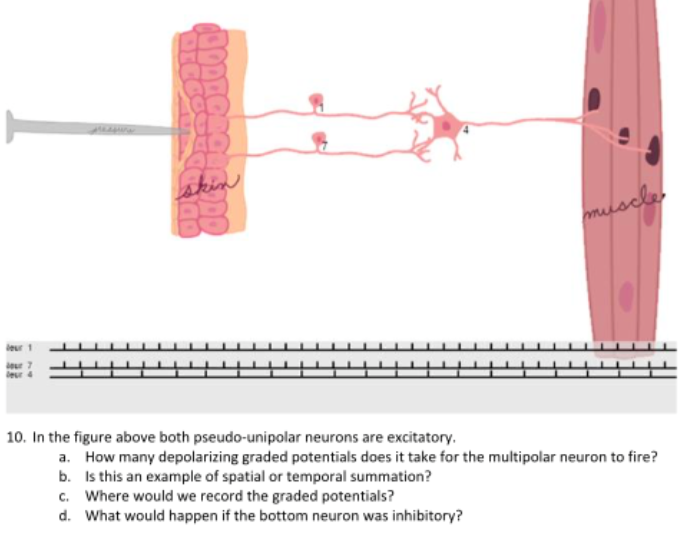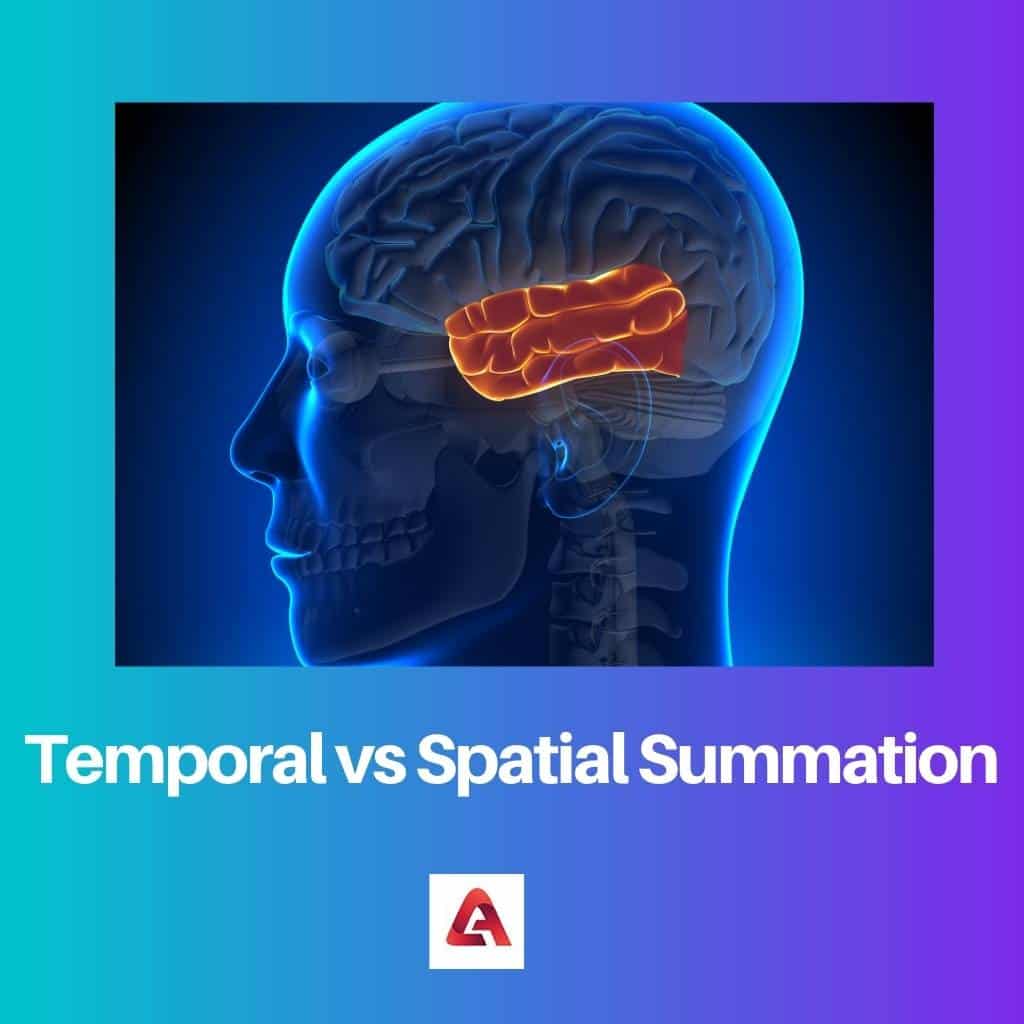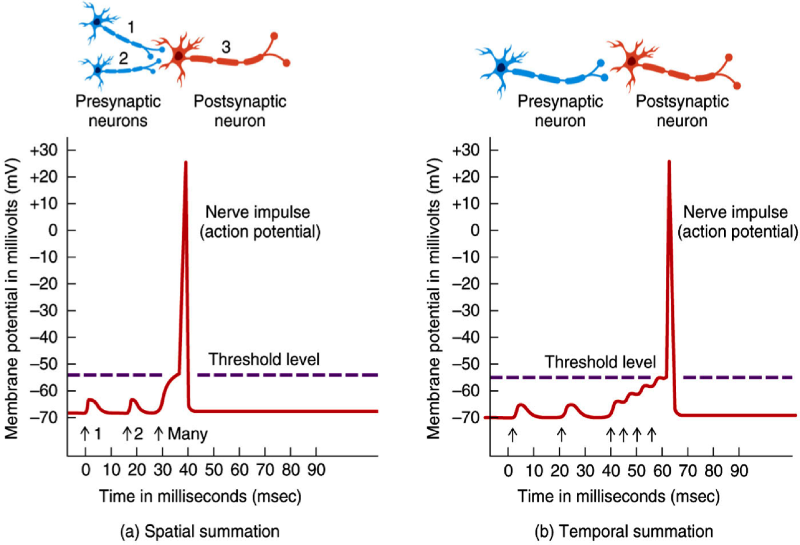
Temporal Vs Spatial Summation Graph Get Images
Summation, which includes both spatial summation and temporal summation, is the process that determines whether or not an action potential will be generated by the combined effects of excitatory and inhibitory signals, both from multiple simultaneous inputs (spatial summation), and from repeated inputs (temporal summation).

Temporal And Spatial Summation Difference, Mechanism, Facts
There is spatial summation when the target neuron receives several inputs from several sources. "Temporal summation" is the effect produced by a particular neuron to be able to achieve an action potential. "Summation" generally occurs depending on how long the time constant is and the frequent occurrence of action potentials.

Major Differences Between Temporal vs Spatial Summation
Together, synaptic summation and the threshold for excitation act as a filter so that random "noise" in the system is not transmitted as important information. Figure 35.7.1 35.7. 1: Signal summation at the axon hillock: A single neuron can receive both excitatory and inhibitory inputs from multiple neurons. All these inputs are added.

Temporal Vs Spatial Summation Overview, Differences, & Examples Phantom Tutors
Both types of summation result in a depolarization of a higher magnitude that when only on excitatory input occurs. Figure 5.1 EPSPs can summate via temporal or spatial summation. Temporal summation occurs when a presynaptic neuron, Input 1 in the figure, stimulates the postsynaptic neuron multiple times in a row.

Temporal Vs Spatial Summation Overview, Differences, & Examples Phantom Tutors
Temporal and spatial summation are two types of summation processes in the nervous system. Moreover, multiple stimuli are involved in firing an action potential. Key Areas Covered 1. What is Temporal Summation - Definition, Mechanism, Importance 2. What is Spatial Summation - Definition, Mechanism, Importance 3.

Temporal Vs Spatial Summation Graph Get Images
SPATIAL VS TEMPORAL SUMMATION. In this video we compare two important means of increasing force of contraction in skeletal muscle: (i) spatial summation (The Size Principle) and (ii) temporal (frequency) summation. This follows on from the " The neuromuscular junction " video which you should watch if you need to revise the basics.

Types of Summation of Stimulus temporal spatial Obv. Similar to name Human anatomy
Frequency summation. For skeletal muscles, the force exerted by the muscle can be controlled by varying the frequency at which action potentials are sent to muscle fibers. Action potentials do not arrive at muscles synchronously, and, during a contraction, only a certain percentage of the fibers in the muscle will be contracting at any given time.

Temporal Summation bartleby
About Press Copyright Contact us Creators Advertise Developers Terms Privacy Policy & Safety How YouTube works Test new features NFL Sunday Ticket Press Copyright.

Major Differences Between Temporal vs Spatial Summation
What exactly is action potential? Definition of synapse (psychology) Process Explainer What is Summation (Temporal Vs Spatial Summation) Temporal Summation Spatial Summation Primary Functions of A Wave Summation Bodily functions possible due to Wave Summation. The term threshold Why MyAssignmenthelp.com is the best choice for students of Biology?

Pin on Systems Nervous
There are two types of summation: spatial and temporal. These two types of summation differ in the number of neurons involved. Both types of summation use IPSPs and EPSPs to produce the.

Temporal vs Spatial Summation Difference and Comparison
The summation can be defined as a process by which the excitatory and inhibitory signals together are able to generate an action potential or not. There are two types of summations, these are temporal and spatial summations, respectively.

SNAB TOPIC 8 Revision Cards in A Level and IB Biology
This concept is called spatial summation. A superthreshold postsynaptic potential which is right next to the active zone of a synapse almost certainly will cause neurotransmitter to be released.

Temporal and Spatial Summation (diagram) Diagram Quizlet
Temporal vs Spatial Summation Spatial summation is when several weak signals from various locations are combined into a single stronger signal, where signals come from multiple simultaneous inputs. While a single source's quick succession of weak pulses is combined into a single, big signal called temporal summation. Science Quiz

Bio 201 Nervous System Flashcards Easy Notecards
Transmission Across a Cholinergic Synapse There are over 40 different known neurotransmitters One of the key neurotransmitters used throughout the nervous system is acetylcholine (ACh) Synapses that use the neurotransmitter ACh are known as cholinergic synapses The detailed process of synaptic transmission using ACh is as follows:

Temporal and Spatial Summation Diagram Quizlet
At the synapse, the firing of an action potential in one neuron—the presynaptic, or sending, neuron—causes the transmission of a signal to another neuron—the postsynaptic, or receiving, neuron—making the postsynaptic neuron either more or less likely to fire its own action potential.

PPT SYNAPTIC PHYSIOLOGY PowerPoint Presentation, free download ID6679624
-Spatial summation occurs when multiple presynaptic neurones together release enough neurotransmitter (e.g. acetylcholine) to exceed the threshold of the postsynaptic neurone. For example, neurone A and neurone B may individually release insufficient neurotransmitter but when these quantities are combined, threshold may be exceeded and an action potential generated.